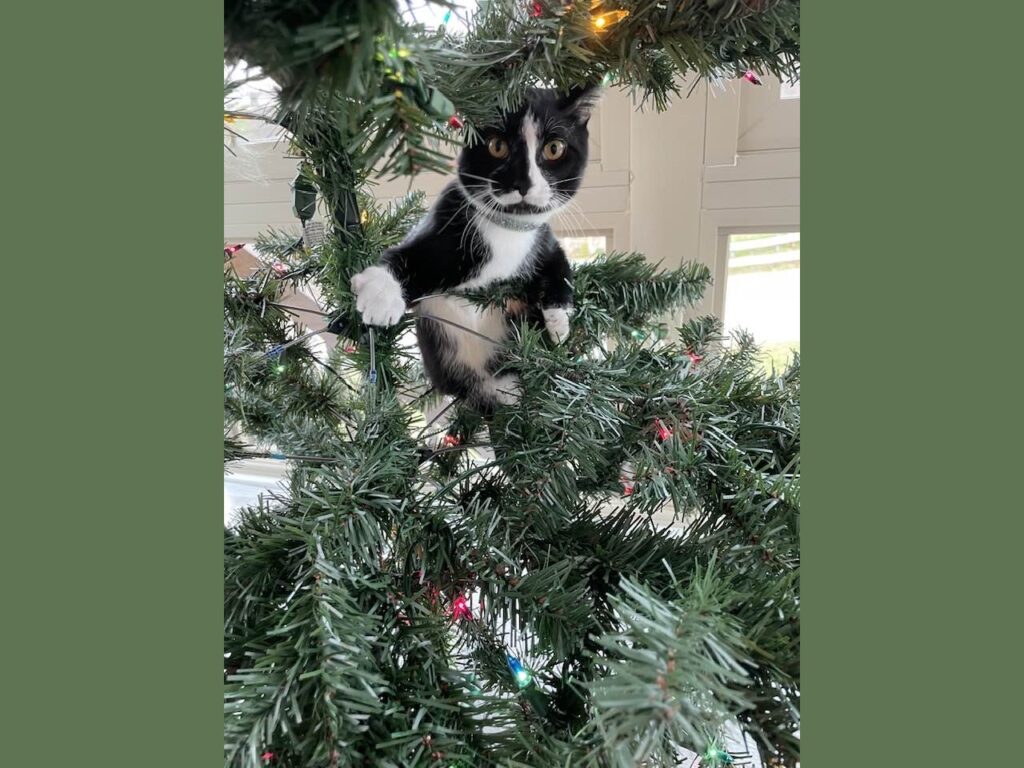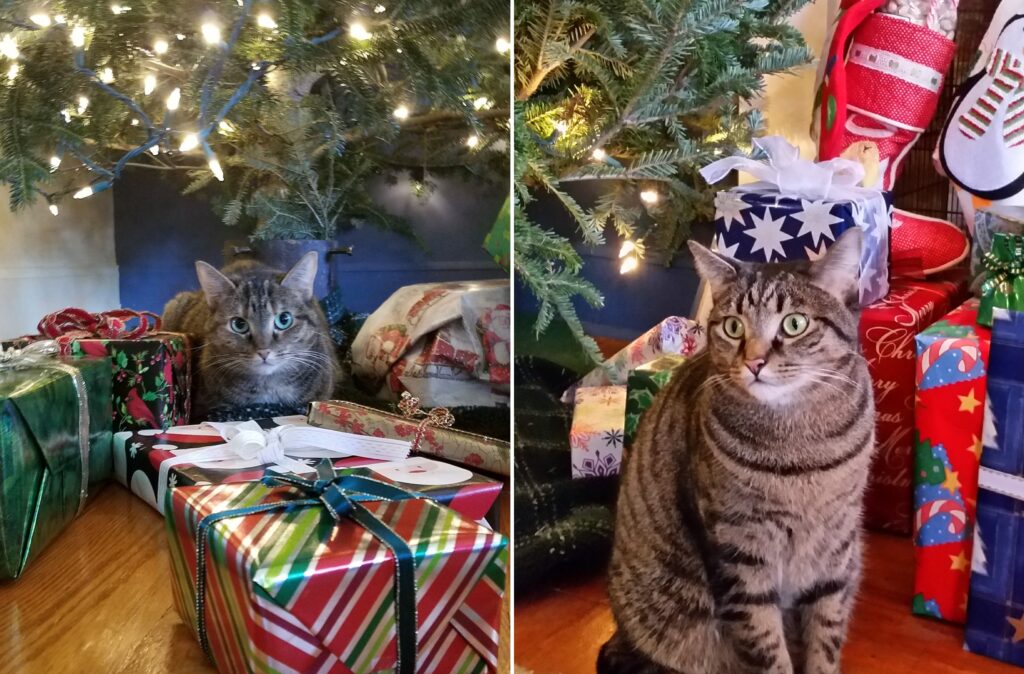The ancient rivalry continues in homes across the world: cats vs. Christmas trees. Direct your browser to YouTube for hours of video evidence or to The Onion for hard-hitting journalism on this annual grudge match. Maybe cats like climbing them, maybe they like playing with the ornaments, or maybe they just delight in destruction. Whatever the reasons in their furry little minds, we have all seen videos and photos in popular culture – and maybe even had first-hand experience – of holiday decorations laid waste by the family feline.
A Tree By Any Other Name
As I mentioned in my Real vs. Plastic Christmas Tree series last year,[1] the cat factor was actually a point of discussion between Christian and me when I first moved in and wanted to get a tree at Christmas. Among the many reasons he didn’t want one (including effort, expense, mess, and fire hazard) was that he claimed the kitties would destroy it. However, based on my own experience, growing up in a house with multiple cats and multiple Christmas trees every year, I pushed back and said that the kitties wouldn’t attack a real tree.
Indeed, I did some legitimate scientific research to back up my point in this blog post: I poured myself a Christmas beer and watched compilations of cat vs. Christmas tree videos on YouTube. Yes, it was a sacrifice, but I did it for science. In approximately 30 minutes of footage, I counted 146 separate cat/tree encounters, which included cats climbing trees, jumping into trees, getting stuck in trees, knocking trees over, and chewing on trees.

Image credit: [2]
Of that total, there were only two trees that might have been real (or were very convincing polyethylene models) being attacked by cats. (Note: I removed three examples from the sample set – the trees looked real, but the cats weren’t actually in them, rather just goofing off near them, not constituting an attack of any kind.) The rest of the 144 examples involved artificial trees. (Another note: I did not include encounters with artificial decorations, such as garlands, but those made appearances as well.) [3],[4],[5],[6]
Attraction to Plastic
This very obvious trend begs the question of what it is about plastic trees (and garlands, etc.) that is so much more attractive to kitties. First, they may simply be easier to climb: there is often more room in between branches, and the branches themselves are distributed evenly in tiers; real trees pose more of a challenge. The second possibility is that the plastic itself is attractive – artificial trees are made of a substance that most cats I know love in one form or another.
Our family kitties are a source of amusement and frustration when it comes to plastic, and it is interesting (and slightly baffling) that they have different preferences. For example, my cat Siegfried likes plastic bags (#4 – LDPE, low-density polyethylene), but Christian’s cat Pumpkin prefers the hard shrink wrap from the tops of bottles and jars (#3 – PVC, polyvinyl chloride), while my mom’s cat Puck prefers to lick his fleece kitty bed (#1 – PET, polyethylene terephthalate). We’re not sure why there are these differences in preference – if it’s a texture thing or a flavor/scent thing – but scientists aren’t entirely sure, either.

Photo credit: Jean Korey
According to National Geographic, some scientists believe a fixation on plastic may be related to a compulsive disorder called “wool sucking,” which involves texture-related licking (and could absolutely be what Puck is doing).[7] Catster.com has a few additional theories that describe how plastic can appeal to multiple senses: crinkly noises are fun for playful kittles; some plastics are “treated with stearates, which are derived from tallow,” making the flavor attractive; and some plastics contain chemicals “that may mimic pheromones or other attractants,” making the smell enticing to kitties.[8]
The vast majority of Christmas trees are made of PVC, but in a softer form than Pumpkin’s personal preference. The problem with having PVC trees is that they can off-gas volatile organic compounds, which can be hazardous to health, and they can contain lead (in fact, California requires a product warning).[9] I went into more detail in last year’s Christmas tree post, but the health risk is significant enough that pregnant women and children are advised to avoid touching them altogether or at least wash their hands after contact.[10] And if chemical and lead exposure aren’t great for developing humans, they’re probably not great for cats either.
Newer, more realistic-looking plastic trees are made of polyethylene – and there were definitely some of those in the YouTube videos – but there are also concerning health and environmental impacts of PE up and down the supply chain,[11] even if they’re likely safer as a Christmas tree option in the house vs. a PVC tree.
Aversion to Real Trees
On the other hand, another likely reason for this overwhelming preference for plastic trees among house cats is that real Christmas trees are not that appealing from a touch or taste perspective. Many real trees have stiff, prickly needles that aren’t as soft as the artificial equivalent, and the branches closer to the trunk can be a lot more densely packed than the alternative, leaving much less room for even small kitties (which ours are not.) Climbing a fake tree would, I think, be a relatively comfortable if not enjoyable experience by comparison.

But more than that, real Christmas trees contain chemicals called “terpenes,” found in most pines and firs. Terpenes give the trees their piney scent, but are also toxic to cats. If ingested either through needles, branches, or sap, terpenes can cause vomiting, diarrhea, lethargy, irregular breathing, and other issues.[12] The general school of thought I have heard from animal and plant experts I know personally is that cats may get irritated enough by an initial test encounter with a real tree through rubbing or biting that they’ll stay away, and the subsequent risk will be low. Ours tend to avoid things that aren’t good for them, such as pine trees and lilies, but your cat’s mileage may vary, and there are no guarantees when it comes to cat behavior. For example, my mom’s cat Puck got very sick a few years ago at Christmas, and while we never figured out why, it could have been from eating a seasonal plant, many of which come with cat warnings.[13]
Whichever type of tree you decide to use – real or plastic – plenty of pet care sources still recommend getting a sturdy base and anchoring your tree to the wall… as well as using cat-proof ornaments.[14] Based on personal experience and a wealth of anecdotal information from the internet, it appears that if you want to avoid attacks on the centerpiece of your holiday decorations, you should go with a real tree. But if you do, it’s still a good idea to keep an eye on the especially mischievous kitties.
~
Have you noticed a pattern of attack when it comes to your cats and holiday decorations? Do they stick to plastic or just go after anything? I’d love to hear about their antics below.
Thanks for reading – and Merry Christmas!
[1] https://radicalmoderate.online/real-vs-plastic-christmas-trees-part-1/
[2] https://www.theonion.com/cat-clinging-to-side-of-christmas-tree-admits-that-was-1849899567
[3] https://www.youtube.com/watch?v=htvCx0FG9Ww
[4] https://www.youtube.com/watch?v=Kb8Lgko3CwU
[5] https://www.youtube.com/watch?v=JcNoFss9g8w
[6] https://www.youtube.com/watch?v=uKJF49DFVLE
[7] https://www.nationalgeographic.com/animals/article/animals-cats-behavior-pets
[8] https://www.catster.com/lifestyle/cat-health-behavior-why-do-cats-lick-plastic-bags
[9] https://www.p65warnings.ca.gov/fact-sheets/lead-and-lead-compounds
[10] https://www.greenchildmagazine.com/6-tips-for-safe-holiday-decorating/
[11] https://radicalmoderate.online/plastic-free-july-2022-part-1/
[12] https://www.thedodo.com/dodowell/are-christmas-trees-toxic-to-cats
[13] https://www.purina.com/articles/cat/care/holiday-plants-poisonous-to-cats
[14] https://www.thedodo.com/dodowell/are-christmas-trees-toxic-to-cats
0 Comments